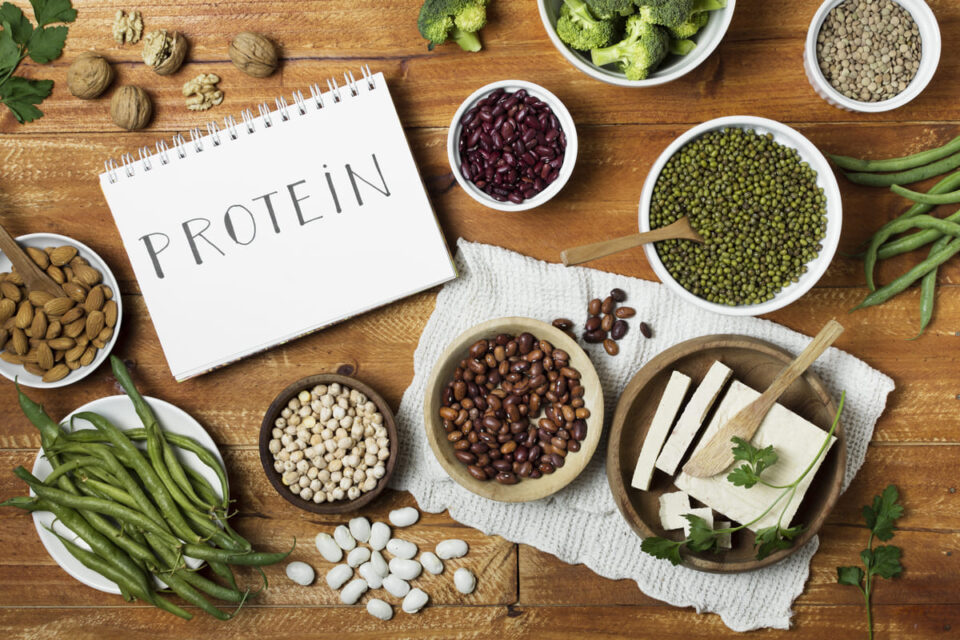Protein. The new obsession. Gym-goers chug whey shakes. Instagram influencers preach about amino acids. But 71% of Indians are still protein deficient—the irony stings.
The protein gap is real. America’s average daily protein intake is 88 grams, while India’s is just 47 grams. It’s not only about wealth. It’s about knowledge, diversifying beyond dal-rice-roti, and understanding our bodies’ needs.
Last month, Vishalakshi, a 32-year-old software engineer, came to me frustrated. “Doctor,” she sighed, “I need more protein, but I’m tired of bland paneer daily. How can I add variety to my vegetarian diet without consuming carbs?” Vishalakshi’s story echoes across my practice – awareness is growing, but practical knowledge lags.
Protein deficiency isn’t just about weak muscles. It’s about broken bones, weakened immunity, and stunted growth in children. The National Nutrition Mission knows this, but change is slow.
The average Indian consumes just 60% of the required protein—36 grams instead of 60 for a 60 kg person. The consequences? Fracture risk is up by 50%. Muscle mass is down 1-2% yearly after 50—a national crisis in the making.
India’s protein sources hide in plain sight. Sattu, the powerhouse of Bihar, packs 20 grams of protein per 100 grams. Chana, the humble chickpea, offers 17 grams. Rajma? 24 grams. Even ragi, the miracle millet, provides 7 grams with a calcium boost.
The protein revolution is here. It’s not about copying the West. It’s about finding our way, balancing tradition with science, taste with health, and economy with nutrition.
Protein-Rich Gems
1. Sattu: Mix with water for a quick protein shake or use in laddoos and parathas.
2. Rajma: Use in classic rajma chawal or get creative with rajma burgers.
3. Chana: From chole bhature to roasted snacks, the possibilities are endless.
4. Ragi: Use flour in rotis, idlis, or morning porridge.
5. Moong Dal: Try moong dal cheela or add to salads.
6. Soya Chunks: Use in biryanis or as a meat substitute in curries.
7. Amaranth (Rajgira): Use flour in rotis or cook grains like porridge.
8. Pumpkin Seeds: Roast with chaat masala for a crunchy snack.
9. Kulath (Horse Gram): Great in soups or ground into flour for dosas.
10. Toor Dal: A staple deserving more recognition for protein content.
From Theory to Practice: Protein-Packed Week for the Indian Professional
1. Monday: Moong sprout chilla. Pack roasted chana for a snack.
2. Tuesday: Overnight oats with yoghurt. Rajma wrap for lunch.
3. Wednesday: Ragi dosa. Chickpea salad with pumpkin seeds for lunch.
4. Thursday: Sattu paratha. Paneer sandwich for lunch.
5. Friday: Soya chunk poha. Dal tadka with brown rice for lunch.
6. Weekend Prep: Roast chickpeas and pumpkin seeds. Prep lentils for the week.
Eating Out Tips
– South Indian: Idli or dosa with extra sambar.
– North Indian: Dal makhani or paneer bhurji.
– Indian – Chinese: Stir-fried tofu or vegetable Manchurian.
– Italian: Whole wheat pasta with lentil balls.
Supermarket Shopping Tips
– Stock up on frozen peas and beans.
– Buy yoghurt or hung curd.
– Choose whole grain bread with added seeds.
– Pick up ready-to-eat lentil snacks.
– Grab protein-fortified atta.
Pro Tips
– Keep protein bars or roasted chana on your desk.
– Order lentil-based dishes or paneer when eating out.
– Pack roasted makhana or soya nuts for travel.
Addressing Common Concerns
1. I’m tired of eating dal daily for protein.
Solution: Explore variety with soya chunks, paneer, or tofu.
2. High-protein diets are only for bodybuilders, right?
Reality Check: Protein is essential for everyone’s overall health.
3. I don’t have time to cook elaborate meals.
Tip: Batch cook on weekends. Store in portions for quick weekday meals.
4. I’m worried about protein quality in vegetarian diets.
Approach: Combine different protein sources for a complete amino acid profile.
5. Plant-based proteins cause bloating and gas.
Solution: Start small, soak legumes, and use digestive spices like ajwain or hing.
6. Protein-rich foods are expensive.
Reality Check: Many Indian protein sources like dals and chana are economical in bulk.
7. I’m diabetic. Won’t carb-heavy lentils raise my blood sugar?
Tip: Pair legumes with low-carb vegetables. Explore low-carb proteins like paneer and tofu.
8. My family dislikes protein powders in smoothies.
Approach: Use natural boosters like yoghurt, chia seeds, or ground nuts.
9. Maintaining a high-protein diet while travelling is hard.
Solution: Carry protein-rich snacks. You can opt for dal-based dishes or paneer tikka at restaurants.
10. I’m worried about calcium intake on a dairy-free, high-protein diet.
Tip: Include non-dairy calcium sources like ragi, sesame seeds, and leafy greens.
Transitioning to a high-protein diet is a journey. Be patient and make gradual changes for lasting results.
Your Health, Your Journey
In the land of lentils and legumes, a protein revolution quietly simmers. Urban Indians, once content with dal-chawal, now scrutinize food labels and debate amino acid profiles with the fervour of seasoned nutritionists.
Yet, as trendy quinoa and imported chia seeds flood supermarket shelves, humble local powerhouses like sattu and horse gram languish in obscurity.
The irony is palpable: in our quest for Western-style protein optimization, we’ve overlooked the treasure trove of plant-based protein that has sustained our ancestors for millennia.
But hope sprouts anew as innovative chefs and health-conscious homemakers alike rediscover and reimagine these Indigenous superfoods, crafting delicious solutions to India’s protein puzzle.
Will we embrace this fusion of tradition and modernity, or will our protein revolution remain half-baked?

